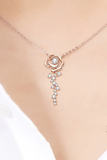Sometimes it just takes a beautiful piece of jewelry to add the finishing touch to a glamorous outfit – but jewelry is complicated and often expensive. We hope the information offered in this post will help you to make some decisions when considering the purchase of jewelry items.
Originally, we were going to discuss gemstones and settings in one post, but the wealth of information on each topic made it necessary to separate the blog post into two parts: Part 1 on Gemstones, and Part 2 on Settings. Even then, we'll have barely scratched the surface on each topic.
Gemstones
There are many types of stones available for jewelry, but we'll discuss some of the most common: Natural mineral gemstones, organic gemstones, synthetic gemstones, and simulated gems.
Natural Gems
Gems are precious and semi-precious minerals -most in crystalline form. Gems come from deep inside the earth, and may take millions of years to form. They are brought closer to the earth’s surface by earthquakes, volcanoes, or shifts in the earth’s crust. Gems are often mined, but they may be found in caves, or in bodies of water such as stream beds.
The more rare a natural gemstone is, the more precious (and expensive) it is. Diamonds, rubies, sapphires, and emeralds are considered precious stones.




You won't go wrong purchasing one of these stones, but see below for other alternatives that may be just as beautiful, but not as costly. Semi-precious stones are usually more affordable, but they may require more care than precious gems.
Durability of gemstones
One factor in determining a gemstone’s wearability is hardness. The hardness of a gem determines its ability to withstand scratching. Hardness is identified using the Mohs hardness scale, which runs from 1 to 10 - with 1 being the softest material (talc), and 10 as the hardest material (diamond) on the scale. To give you some perspective, a fingernail has a hardness of 2.5, which is quite soft.
A material with a higher number on the hardness scale, can scratch a material lower on the scale. A diamond, the hardest natural material, has a hardness of 10, and can only be scratched by another diamond.
In movies, you’ve seen a person using a diamond to cut glass. The hardness of glass is 6.5, so it can absolutely be scratched by a diamond - which is a much harder material.
Other precious stones, sapphires and rubies have a hardness of 9, while an emerald’s hardness is around 8. The harder the stone, the less likely it will become scratched through normal use.
There are a multitude of semi-precious stones. Many of these rank from 6.5 – 8 on the hardness scale. Stones with a hardness of less than 7, are more susceptible to scratching than their harder counterparts. Normal wear and tear, or even rubbing against each other in a jewelry box may cause stones to scratch.


Jewelry box with dividers - YES! Storage box without dividers - NO!
Never store your gemstone jewelry loosely with diamond jewelry, as the diamonds are capable of scratching any other stone.
According to the International Gem Society (https://www.gemsociety.org/article/hardness-and-wearability/ ), common dust may have small particles of quartz in it. Quartz has a hardness of 7 – 7.5. This means that dust might scratch any material with a lesser hardness – including glass (6.5 hardness). And when you rub your semi-precious stones to remove dust, it could create tiny microscopic scratches in the stone. The scratches may not be visible at first; but given the same treatment over time, the scratches could multiply to a point where they become noticeable.
Hardness of some common semi-precious stones:

Though gemstones lower on the hardness scale may develop scratches over time, with proper care and storage, they will continue to look beautiful for many years.
Aside from scratching, there are other factors (not related to hardness) which may affect certain stones. Striking the stone may cause it to chip or shatter. Excessive heat, cold, bright sunlight, or exposure to chemicals, may weaken or ruin some stones. Even water may affect some gemstones, causing them to crack or dissolve.
You may want to reserve wearing less durable stones for special occasions, instead of everyday wear. Or purchase these stones as earrings or pendants, which receive less wear and tear than rings.
Which brings us to…
Organic gemstones
Organic gems are formed from living organisms, rather than from minerals contained in the earth’s crust. Though there are several more, the most common organic gems used for jewelry are:
 Pearls – Pearls may be natural or cultured, and are produced when a small irritant, like a grain of sand, becomes lodged inside a mollusk. To protect itself from the foreign object, the mollusk coats it with layers of mother of pearl nacre, which hardens and forms a pearl. Pearls may found in many colors, but the most common is white or cream. The pearl’s hardness is 2.5 -4.5.
Pearls – Pearls may be natural or cultured, and are produced when a small irritant, like a grain of sand, becomes lodged inside a mollusk. To protect itself from the foreign object, the mollusk coats it with layers of mother of pearl nacre, which hardens and forms a pearl. Pearls may found in many colors, but the most common is white or cream. The pearl’s hardness is 2.5 -4.5.
 Amber – Amber is hardened tree resin, fossilized over millions of years. The most common color of amber is yellowish-orange. When genuine amber is warmed in your hand, it will give off a pleasant, pine-like odor. The hardness of amber is 2.5.
Amber – Amber is hardened tree resin, fossilized over millions of years. The most common color of amber is yellowish-orange. When genuine amber is warmed in your hand, it will give off a pleasant, pine-like odor. The hardness of amber is 2.5.
 Abalone – Abalone is a sea snail. The interior of the abalone shell is commonly a blue- green iridescent color, and is often used in crafting jewelry. The snail may also produce abalone pearls. The hardness of abalone is 3.5.
Abalone – Abalone is a sea snail. The interior of the abalone shell is commonly a blue- green iridescent color, and is often used in crafting jewelry. The snail may also produce abalone pearls. The hardness of abalone is 3.5.
 Jet – Jet is a form of coal. It is fossilized driftwood, that was formed under heat and pressure over millions of years. Jet is black or dark brown in color, and lightweight compared to other gemstones. There is hard jet (4.0 hardness) and soft jet (2.5 hardness). Hard jet is the result of compression in salt water, and soft jet is the result of compression in fresh water.
Jet – Jet is a form of coal. It is fossilized driftwood, that was formed under heat and pressure over millions of years. Jet is black or dark brown in color, and lightweight compared to other gemstones. There is hard jet (4.0 hardness) and soft jet (2.5 hardness). Hard jet is the result of compression in salt water, and soft jet is the result of compression in fresh water.
As you can see from those listed above, many organic gems are much softer than mineral derived gems, making them more easily damaged. They may require more or different care than mineral derived gems.
Lab created / synthetic stones
Technology has improved to the point where gemstones may be produced in a lab. Lab created gemstones are identical to natural gemstones in appearance and composition. Specific processes are performed in the lab that mimics the formation of natural stones. One feature of lab created stones, is that they contain fewer imperfections than natural gemstones.
Lab created stones are not mined, and therefore create less stress on the environment that mining entails, and they are not a factor in the question of ethical mining practices. Lab created stones may save you as much as 80% of the cost of natural stones.
Lab grown diamonds
Lab grown, or synthetic diamonds are identical to natural diamonds. The lab grown diamond is also a 10 on the hardness scale. Just as a natural diamond reflects white light when it sparkles, so do lab grown diamonds. Often a jeweler cannot even tell if a diamond is natural or lab grown.
Moissanite
Moissanite is a crystal that was discovered by the scientist Henry Moissan. The stone was discovered inside the crater of a meteor that had landed in Arizona. The crystal is very shiny, and similar in appearance to a diamond, but the chemical composition is different. The hardness of Moissanite is 9. Moissanite’s appearance differs from a diamond in that it sparkles more, and it sparkles in rainbow colors (rather than white as a diamond does). Moissanite may sometimes have a yellow, green, or pinkish hue.
Natural Moissanite is very rare. The Moissanite stones sold as jewelry are actually lab-created, and chemically identical to natural moissanite. Moissanite costs less than a diamond, and is often purchased in place of diamond, but Moissanite is a beautiful gemstone in its own right.
Simulated stones/ man-made stones / imitation gems
Simulated stones are stones made of glass or plastic, or some other material that does not have the same chemical composition as natural or lab-grown synthetic stones. These imitation stones are not as resistant to wear or damage as natural stones are.
Imitation stones are mass produced, and are often used in costume jewelry. Because costume jewelry is so low cost, it is sometimes made with low quality metal settings that can irritate your skin or tarnish easily.
Cubic zirconia is a simulated stone which is a popular alternative to a diamond, but it is not as brilliant as a diamond. Cubic zirconia is also known for clouding over, and losing its sparkle over time. The hardness of a cubic zirconia is 8.
So which gems are affordable and will last?
The most durable stones that will retain their value over the years are precious gems. The natural, mined versions of these stones will cost multiple thousands of dollars per carat, depending on the quality of the stone. Lab created stones can be 60% -80% less than natural stones. Since they have the same chemical composition, the quality of synthetic/ lab-created stones will be the same or better than natural stones.
Semi-precious stones and organic gems are cheaper still. The trade off is that these gems may require more care and special handling. Some pearls (both natural and cultured), could run into multiple thousands of dollars depending on their size and quality. Cultured pearls usually cost less than natural pearls, because they are not as rare.
Simulated stones are low cost, and can usually be found in costume /fashion jewelry.
No matter which gemstones you purchase, It is best to follow the care instructions for your particular jewelry piece to keep it sparkling and looking like new, and to maintain it's value for years to come. If you don’t receive specific instructions with your jewelry purchase, you may want to spend a little time researching the stone, to determine how best to care for it.
Check out our jewelry accessories at Spellbound Elegance-
Next...
Stay tuned for the next installment dealing with metal settings and their durability: Affordable Jewelry that Lasts - Part 2 Settings.
Additional sources:
1. Gemological Institute of America, https://4cs.gia.edu/en-us/
The Gemological Institute of America has an excellent article about caring for your gemstones: https://4cs.gia.edu/en-us/blog/more-than-mohs-scale-gem-durability/
2. International Gem Society,https://www.gemsociety.org/













